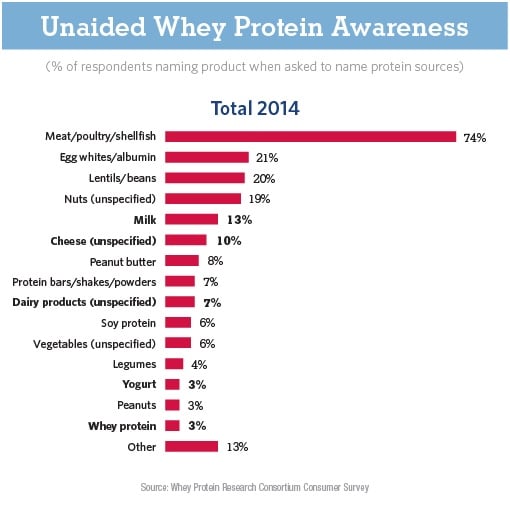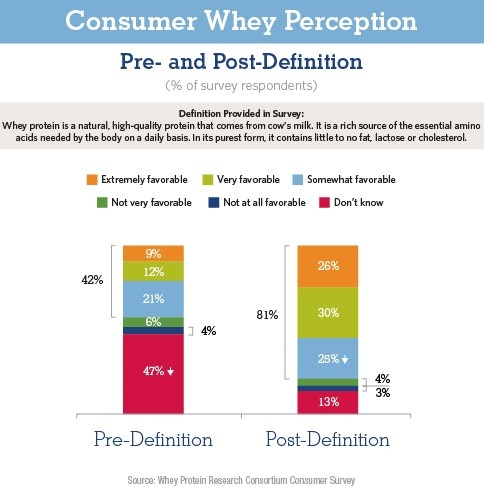-
5 Research-Based Strategies to Improve Whey Protein Messaging
By Margaret Speich February 18, 2016- Tweet
Communication based on science will gradually grow demand.
Whey protein is a product perfect for the times.
Consumers around the world are looking to increase the amount of protein in their diets for a variety of reasons. Researchers continue to amass data that sets whey protein ahead of alternative protein sources in terms of nutritional quality and the ability to deliver on consumer lifestyle goals.

Unfortunately, studies show most consumers are not getting the full message about whey protein. Untapped potential remains.
"The research shows there is no doubt that science-based communications will create gradual demand for whey protein in many developed markets and can help protect established markets," says Véronique Lagrange, senior vice president, strategy and insights, at the U.S. Dairy Export Council.
USDEC, in collaboration with the Whey Protein Research Consortium, commissioned multiple market studies on consumer perceptions, consumption patterns and purchasing behavior for whey protein.
Citing these studies, Lagrange and Michael Gromek of Dairy Management Inc. (DMI) recently wrote an article, "Education and Messaging: An Effective Way to Increase Demand for Whey Proteins in Developed Countries," for the European Dairy Journal.
While the studies analyzed were of U.S. consumers, Lagrange and Gromek see opportunities to improve messaging both domestically and internationally.
“We are actively engaged in sharing this information with manufacturers and multi-nationals, allowing them to fine-tune communications and promotions to better target consumers with messaging and products,” says Lagrange. “A rising tide lifts all boats.”
Based on the research (two surveys were conducted, one in 2011 and another in 2014), Lagrange and Gromek identified strategies, including these five, for building the global case for whey protein consumption:
1. It may sound basic, but emphasize the protein in whey protein.
Consumer attitudes toward protein remained positive overall from 2011 to 2014. More than half associate protein with a variety of valuable benefits, including: “Achieving a balanced diet,” “More complete/quick muscle recovery after exercise,” “Preventing muscle loss during aging,” “Not feeling hungry between meals,” “Maintaining healthy bones and joints,” and “Increasing lean muscle mass definition without bulking”.
At the same time, nearly two-thirds of consumers said they do not get enough protein in their diets, a significant increase from the 2011 survey. Plus, almost half of respondents identified themselves as “a little too heavy around the waist,” while others said they desired more muscle, needed more strength or wanted to firm up or tone certain areas of the body.
“Overall, the benefits consumers believe protein can deliver are well-aligned with their body composition and lifestyle goals as well as whey protein research findings,” says Lagrange. “That spells opportunity for dairy. Helping consumers think ‘whey protein’ rather than ‘meat,’ ‘soy’ or ‘pea’ when they seek out a protein product in the store will help the dairy sector gain a bigger slice of the expanding global protein market.”
2. Educate consumers that whey protein comes from milk.
When asked about the origin of whey protein, one-third of consumers said they have no idea where it comes from. More than one-third believes it is plant derived (most from wheat). In all, only about 30 percent of respondents identified milk as the source of whey protein.
There might be some U.S. bias in those answers—whey-based drinks have been marketed for decades in some European countries, and other languages lack the alphabetical resemblance between “whey” and “wheat” that is likely behind some of the confusion expressed in the survey.
“But given that both the 2011 and 2014 research indicated a tremendous boost in favorability when consumers knew whey protein derived from milk, any response to this question other than ‘milk’ represents an ongoing opportunity to better educate consumers and grow demand,” says Lagrange.

3. Correct the misconception that protein is just for bodybuilders.
Despite favorable overall responses to protein, simply emphasizing whey as a high-quality protein source is no magic bullet to greater sales. Although protein registers high favorability with consumers, persistent misconceptions still cloud potential.
In fact, compared to the 2011 study, a greater number of adults believe “Protein is just for body builders” and “Women shouldn't eat too much protein or their muscles can get bulky.” Respondents agreeing with both those statements skewed toward those considered favorable target markets, including women.
“Marketers should communicate and message about those topics—what proteins ‘do not do’ and the levels that can be safely eaten—in particular among women,” says Lagrange.

4. Improve and market whey protein's taste.
When asked about barriers to whey protein consumption, one hurdle stood above the rest: taste. Taste as a sales barrier was the only attribute to register a statistically significant increase from 2011 to 2014.
“With the growth of whey protein products in recent years, we believe the increase might be due to athletes consuming products containing higher concentrations of protein and/or mainstream adults starting to incorporate whey protein into their normal diets,” says Lagrange.
In either case, close collaboration between whey protein suppliers and end-users is key to overcoming taste issues. Once taste is improved, it's marketers' turn to convey the message.
“We need to continue to invest in application research to develop better flavors for serious athletes, such as bodybuilders, as well as everyday consumers looking to improve their diets who may be less familiar with the taste of whey protein,” says Lagrange.
5. Create different whey protein messages for different consumers.
Survey findings differed among sub-groups in the overall analysis, according to age, gender, lifestyle and general body composition: an indication that communication messages can be effectively tailored to various population groups in order to further increase their interest in whey protein. Some examples of those subgroups and tactics:
- Fat-Loss Believers (including anyone concerned with weight). Messaging: weight management and fat loss. Although men are less focused on the weight loss benefits associated with whey protein, more men are following a variety of diets than in 2011. Therefore, efforts to address weight loss and overall weight management will likely resonate with many.
- Athlete Exercisers. Messaging: muscle strengthening and recovery aspects of whey protein, with a focus on the pre-/post-workout recovery aspects of milk. Active consumers are more likely to consult personal trainers and coaches and value their input when trying new or “healthy” products, so communication targeting those positions is advised.
- Older Consumers. Messaging: whey protein’s role in preventing muscle/bone loss and helping adults stay active as they age. The best way to reach and this growing demographic with information on healthy aging with dairy and whey protein is through health professionals.
The importance of ongoing research
Further whey protein research will help the industry better address the
needs and concerns of specific market segments, improve product taste and increase innovation.That, in turn, will sharpen messaging.
Ongoing research is underway—funded by members of the Whey Protein Research Consortium, the U.S. National Dairy Council, USDEC and several international organizations—which continue to identify tangible and desirable health benefits for whey proteins, supporting the growth of the industry and contributing to measurable health outcomes for consumers.
Says Lagrange, “It is possible to dramatically improve consumer perceptions of whey protein by providing people with simple messages about source and quality. Even in countries where the regulatory environment tightly controls messaging and potential claims, whey suppliers and end-users should be in a position to create incremental demand for their products.”
Learn more: Related articles on whey products have appeared in the U.S. Dairy Exporter Blog:
- Most Consumers Don't Know Whey Comes From Milk
- With Protein, U.S. Dairy Plays to its Strengths
- Global Boom of 65+ Population Opens Door for U.S. Whey Protein
Subscribe to the U.S. Dairy Exporter Blog
The U.S. Dairy Export Council fosters collaborative industry partnerships with processors, trading companies and others to enhance global demand for U.S. dairy products and ingredients. USDEC is primarily supported by Dairy Management Inc.through the dairy farmer checkoff. How to republish this post.
10 Most Recent Posts
Most Popular Posts in Past Year
Index of Posts by Topic
- #GotDairyJobs (4)
- About USDEC (66)
- Africa (6)
- Australia (4)
- Blog (8)
- Brazil (4)
- Canada (20)
- Central America (1)
- Cheese (58)
- Chile (1)
- China (54)
- Common food names (7)
- Company News (19)
- Consistent Supply (1)
- Crisis Management (3)
- Cuba (2)
- Dairy (6)
- Dairy checkoff (9)
- Dairy Ingredients (5)
- Dairy Management Inc. (2)
- Dairy Resources (1)
- Dairy Supply Chain (1)
- Dairy Trends (5)
- Documentation (3)
- EU (24)
- Experts on Dairy Exports (4)
- Exporter of the Year (2)
- Exports (24)
- Farmer leaders (1)
- Farming (38)
- Food Aid (8)
- Food Safety (8)
- Foodservice (3)
- Free trade agreements (34)
- Future trends (1)
- Geographical Indications (GIs) (10)
- Global Marketing (86)
- Global Shipping Crisis (1)
- Got Jobs? (9)
- Indonesia (1)
- Innovation (17)
- Japan (17)
- Krysta Harden (1)
- Market Access (25)
- Market Conditions (268)
- Member Services (17)
- Mexico (41)
- Middle East (9)
- Middle East & North Africa (3)
- Middle East/North Africa (9)
- Milk (4)
- Milk Protein Concentrate (MPC) (2)
- New Zealand (11)
- Next5% (20)
- Nonfat Dry Milk/Skim Milk Powder (8)
- Nutrition (19)
- Product Innovation (6)
- Protein (4)
- Regulations (5)
- Research & Data (326)
- Russia (3)
- Singapore (10)
- South America (8)
- South Korea (10)
- Southeast Asia (25)
- Strategic Insights (1)
- Supply (1)
- Sustainability (26)
- Technology (2)
- ThinkUSADairy (5)
- TPM23 (1)
- TPP (13)
- Traceability (8)
- Trade Barriers (5)
- Trade Data (7)
- Trade Policy (72)
- TTIP (5)
- UHT Milk (7)
- USMCA (2)
- Vietnam (4)
- Whey (6)
- Whey Ingredients (2)
- Whey products (10)
- Whole Milk Powder (WMP) (3)
- World Dairy Expo (1)
- World Milk Day (1)
- Yogurt (1)
Index of Posts by Date, Author
- June 2021 (13)
- March 2015 (12)
- September 2015 (12)
- April 2015 (11)
- December 2015 (11)
- March 2014 (10)
- February 2015 (10)
- October 2015 (10)
- October 2014 (9)
- June 2015 (9)
- July 2015 (9)
- November 2015 (9)
- March 2016 (9)
- October 2019 (9)
- September 2013 (8)
- May 2015 (8)
- August 2015 (8)
- January 2016 (8)
- February 2016 (8)
- March 2017 (8)
- December 2018 (8)
- May 2019 (8)
- December 2019 (8)
- June 2014 (7)
- November 2016 (7)
- May 2017 (7)
- May 2018 (7)
- July 2020 (7)
- June 2023 (7)
- July 2016 (6)
- August 2018 (6)
- October 2018 (6)
- November 2018 (6)
- February 2019 (6)
- June 2019 (6)
- August 2019 (6)
- March 2020 (6)
- April 2020 (6)
- June 2020 (6)
- June 2022 (6)
- February 2014 (5)
- June 2016 (5)
- August 2016 (5)
- September 2016 (5)
- December 2016 (5)
- February 2017 (5)
- July 2017 (5)
- October 2017 (5)
- January 2018 (5)
- April 2018 (5)
- June 2018 (5)
- July 2018 (5)
- September 2018 (5)
- January 2019 (5)
- March 2019 (5)
- April 2019 (5)
- July 2019 (5)
- September 2019 (5)
- November 2019 (5)
- January 2020 (5)
- August 2020 (5)
- October 2020 (5)
- April 2021 (5)
- January 2022 (5)
- May 2013 (4)
- September 2014 (4)
- April 2016 (4)
- May 2016 (4)
- October 2016 (4)
- January 2017 (4)
- April 2017 (4)
- June 2017 (4)
- August 2017 (4)
- September 2017 (4)
- December 2017 (4)
- February 2018 (4)
- February 2020 (4)
- May 2020 (4)
- February 2022 (4)
- September 2022 (4)
- April 2023 (4)
- December 2023 (4)
- November 2017 (3)
- March 2018 (3)
- September 2020 (3)
- December 2020 (3)
- February 2021 (3)
- May 2021 (3)
- August 2021 (3)
- December 2021 (3)
- March 2022 (3)
- April 2022 (3)
- May 2022 (3)
- October 2022 (3)
- December 2022 (3)
- May 2023 (3)
- July 2023 (3)
- November 2023 (3)
- March 2011 (2)
- June 2011 (2)
- September 2011 (2)
- March 2012 (2)
- June 2012 (2)
- July 2012 (2)
- March 2013 (2)
- July 2013 (2)
- November 2020 (2)
- January 2021 (2)
- March 2021 (2)
- July 2021 (2)
- September 2021 (2)
- October 2021 (2)
- November 2021 (2)
- July 2022 (2)
- August 2022 (2)
- January 2023 (2)
- March 2023 (2)
- October 2023 (2)
- January 2024 (2)
- February 2024 (2)
- April 2024 (2)
- June 2024 (2)
- July 2024 (2)
- November 2024 (2)
- December 2024 (2)
- February 2025 (2)
- June 2025 (2)
- July 2025 (2)
- September 2025 (2)
- November 2025 (2)
- January 2010 (1)
- February 2010 (1)
- March 2010 (1)
- April 2010 (1)
- May 2010 (1)
- June 2010 (1)
- July 2010 (1)
- August 2010 (1)
- September 2010 (1)
- October 2010 (1)
- November 2010 (1)
- December 2010 (1)
- January 2011 (1)
- February 2011 (1)
- April 2011 (1)
- May 2011 (1)
- July 2011 (1)
- August 2011 (1)
- October 2011 (1)
- November 2011 (1)
- December 2011 (1)
- January 2012 (1)
- February 2012 (1)
- April 2012 (1)
- August 2012 (1)
- September 2012 (1)
- October 2012 (1)
- November 2012 (1)
- December 2012 (1)
- January 2013 (1)
- February 2013 (1)
- April 2013 (1)
- June 2013 (1)
- August 2013 (1)
- October 2013 (1)
- November 2013 (1)
- December 2013 (1)
- January 2014 (1)
- April 2014 (1)
- May 2014 (1)
- November 2022 (1)
- February 2023 (1)
- August 2023 (1)
- September 2023 (1)
- March 2024 (1)
- May 2024 (1)
- August 2024 (1)
- September 2024 (1)
- October 2024 (1)
- January 2025 (1)
- March 2025 (1)
- April 2025 (1)
- May 2025 (1)
- August 2025 (1)
- December 2025 (1)
- USDEC (183)
- USDEC Staff (163)
- Alan Levitt (119)
- Tom Suber (41)
- Margaret Speich (22)
- Marc A.H. Beck (15)
- Vikki Nicholson-West (11)
- Angélique Hollister (11)
- Tom Vilsack (8)
- Jaime Castaneda (7)
- Matt McKnight (7)
- Véronique Lagrange (7)
- Margaret Speich and Mark O'Keefe (7)
- Ross Christieson (7)
- Paul Rogers (6)
- Shawna Morris (5)
- William Loux (5)
- Alan Levitt and Marc Beck (5)
- Krysta Harden (4)
- USDEC Communications (3)
- Kristi Saitama (3)
- Marilyn Hershey (3)
- Brad Gehrke (3)
- Tom Quaife (2)
- Nick Gardner (2)
- Jim Mulhern (2)
- Alan Levitt and William Loux (2)
- Kara McDonald (2)
- Luke Waring (2)
- Merle McNeil (2)
- Andrei Mikhalevsky (1)
- Rodrigo Fernandez (1)
- Dermot Carey (1)
- Jeremy Travis (1)
- Annie Bienvenue (1)
- Ross Christieson and Shawna Morris (1)
- Becky Nyman (1)
- Paul Rogers and Tom Quaife (1)
- Rick Ortman (1)
- Tony Rice (1)
- Barbara O’Brien (1)
- Paul Rogers and Mark O'Keefe (1)
- Dalilah Ghazalay (1)
- Amy Wagner (1)
- Mitchell Bowling (1)
- Erica Louder (1)
- Brad Scott (1)
- Amy Foor (1)
- Scott Lantz (1)
- Sandra Benson (1)
- Errico Auricchio (1)
- Jaclyn Krymowski (1)
- Krysta Harden, USDEC President and CEO (1)
.png)

